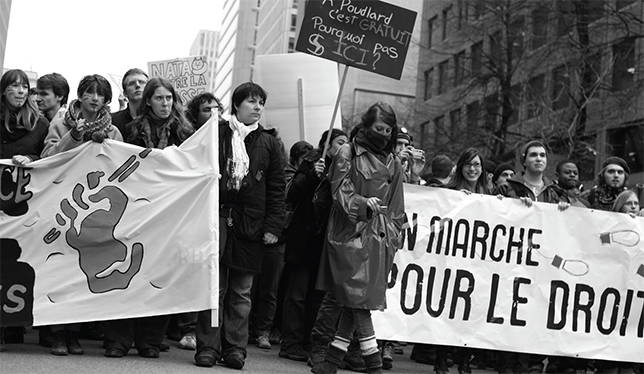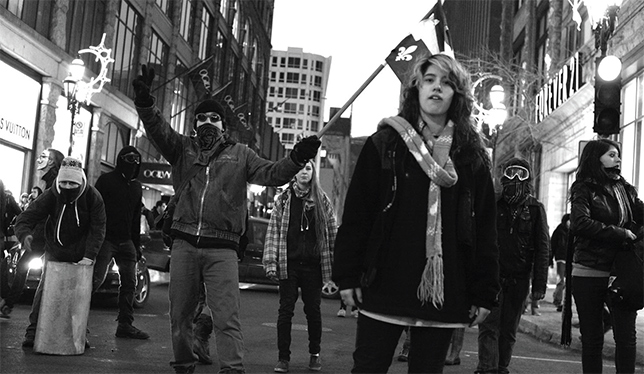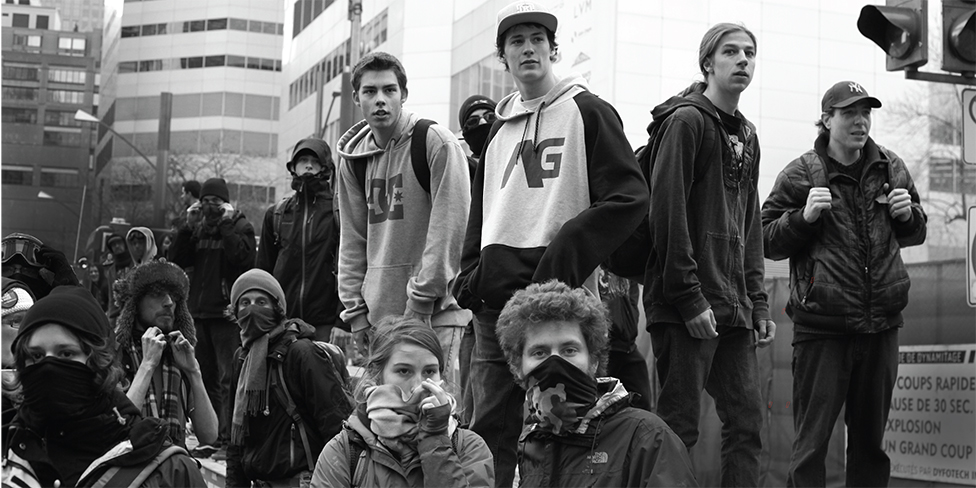“We are crossing a great wilderness,” says Guy Breton, rector of Université de Montréal. “The Maple Spring paralyzed everyone who criticized the underfunding of universities. No one wants to take up our cause, especially not politicians. Nobody wants to discuss funding, let alone tuition fees. These have become toxic topics.”
In March 2011, Jean Charest’s Liberal government announced that university tuition fees in Quebec would rise from $2,168 in 2012-13 to $3,793 in 2016-17, a 75 percent increase. The effect was like a thunderbolt to the student movement, whose members consider low tuition sacrosanct in promoting access to postsecondary education. Students formed a broad province-wide coalition and the first salvo in what was to become known as the Maple Spring, or Printemps érable, was fired on February 7, 2012 when students approved a strike mandate at the Collège de Valleyfield southeast of Montreal.
A month later, out of some 400,000 postsecondary students in Quebec, roughly half were on strike. On March 7, an estimated 200,000 people – many wearing a small red square that became a symbol of the protests – marched in downtown Montreal. This mobilization, which developed into a vast social movement that went beyond the issue of tuition fees, lasted for months and is credited with helping to bring down Quebec’s Liberal government. In September 2012, its electoral defeat at the hands of the Parti Québécois sounded the death knell for tuition fee increases.

For science historian Yves Gingras of Université du Québec à Montréal, the Maple Spring was a resounding success, because it nipped a substantial tuition fee hike in the bud, thereby safeguarding access to university studies and reducing the risk of increased student indebtedness. “But,” he points out, “it failed to resolve the crisis in universities caused by the drop in their public funding.”
Hard on the heels of the election of a minority PQ government, a summit on postsecondary education was held – a gathering that raised the hopes of UQAM rector Robert Proulx. “We discussed a legal framework for universities, setting up a Council of Quebec Universities and reinvesting. And we spent a lot of time talking about the role of universities,” he recalls, “but little emerged in the way of concrete results.” As it turned out, the PQ barely had time to index tuition fees and impose cuts of $250 million before going to the polls again – and losing.
Universities starved of oxygen
The Liberals returned to power in April 2014 with a revamped agenda: goodbye tuition fee increases, hello budget cuts. Philippe Couillard’s government was set on achieving a zero-deficit mark as quickly as possible. “The decisions were not aimed at universities in particular, because almost all government departments were hit,” says Dr. Gingras. “But, for universities, the result was difficult to deal with.”
“Since 2012, cutbacks have deprived Quebec universities of close to a billion dollars, while student numbers have risen by 10 percent,” says Jean-Marie Lafortune, president of the Fédération québécoise des professeures et professeurs d’université, or FQPPU, which represents Quebec university teachers. “Quebec is short almost 2,600 professors. The FQPPU and rectors would like to see a ratio of between 18 to 20 full-time equivalent (FTE) students per instructor, and the ratio currently stands at 25.5.”
The cutbacks have occasioned substantial difficulties. At Université du Québec en Abitibi-Témiscamingue, rector Johanne Jean had to absorb a 6.7-percent cut in her operating budget for the 2015-16 year alone. “We have increased remote services, bringing up our student numbers, thus protecting our funding,” she says. “To bring our costs down, we are increasingly sharing our facilities and expertise in the region with the Abitibi-Témiscamingue CEGEP (junior college). Many projects have been shelved, including those involving First Nations. We have also reduced hiring of faculty.”
At Université de Sherbrooke, sacrifices have been made by both employees and students. “The unions agreed to forgo salary increases and the creation of positions, and vacant positions have not been filled,” says rector Luce Samoisette. “We have introduced non-mandatory institutional fees, which appear on students’ bills. This situation cannot last.”
Government disengagement is not the only aspect of funding that raises the ire of rectors. Many call into question the formula for calculating provincial funding, which is based on university course credits.
Thirty credits are equivalent to one FTE. The more students a university has, the more money it gets. In a context of underfunding, this formula drives universities to compete fiercely, going so far as to set up points of service for students hundreds of kilometres away from the home campus.
“There are now 250 university service points in Quebec,” notes Dr. Breton of U de Montréal. “Why not create funding ranges that would enable universities to keep the same funding in the medium term, for example, even though enrolments vary from one year to the next?”
For Dr. Jean at UQAT, it is clear that the issue cannot be addressed unless there is reinvestment. “Before rectors are ready to re-examine the proportions of public funding per university, the total amount of funding will have to rise,” she says. “Nobody wants to take the risk of losing money because of a new formula.”
Universities disunited
“In 2012, politicians realized that attempting to impose higher tuition fees came with a political cost, but there seems to be none attached to neglecting universities,” says UQAM’s Dr. Proulx. The fact that rectors and students today are failing to present united fronts does nothing for their political clout. The Conférence des recteurs et des principaux des universités du Québec, or CREPUQ, representing Quebec’s university heads, and the Fédération étudiante universitaire du Québec, representing students, both imploded in 2014 and 2015, respectively. Now neither rectors nor students are speaking with one voice.
In January 2014, CREPUQ became the Bureau de coopération interuniversitaire, or BCI, whose mission is to maintain collaboration between universities regarding services (common purchases for libraries, consensus-building, etc.). But the bureau does not have a mandate to speak on behalf of all universities.
“There were clear differences in the problems facing, say, urban universities that have medical faculties and regional universities worried about a drop in the student numbers because of unfavourable demographics,” says Dr. Breton. “CREPUQ was having more and more difficulty defending one or the other.”
Dr. Jean of UQAT agrees. “Barely 25 percent of our students have followed the classic high school-CEGEP-university academic route. The others have atypical paths. Many of them are women, often single mothers, coming back to finish their studies. The vast majority are first-generation students. For the types of students we have, an increase in tuition fees constitutes a real obstacle to a university education and to student perseverance. It’s not the only obstacle, but it is considerable. It was difficult to achieve unanimity on issues like that within CREPUQ, even though we often managed to reach a consensus.”

As the absence of a mouthpiece for universities makes itself felt, the BCI’s role is already starting to change. “Without going back to what CREPUQ was, the BCI can act as a representative on issues that unite all the universities,” suggests Dr. Breton. And it is already doing that, for example, in terms of combating sexual harassment on campuses.
On the student side, a new association was born in April 2016. The Union étudiante du Québec, or UEQ, brings together six student federations, although only one of them is of a substantial size, the Fédération des associations étudiantes du campus de l’Université de Montréal. “A number of non-member student associations take part in our debates, without having the right to vote,” explains UEQ president Nicolas Lavallée. “Officially, we represent 72,000 students, but the federations that participate in our work account for more like 120,000.”
Mr. Lavallée firmly believes that students must have a strong voice within Quebec. For now, the UEQ’s main demands focus on financial assistance for students, on the recovery of money related to the abolition of the federal income tax credit for tuition, education and textbooks, and on the fight against budget cuts.
But the question of tuition fees is never far away. “We hear people criticizing the tuition fee freeze, but fees have been increasing steadily for the past 10 years,” says Mr. Lavallée. “The government is attempting to link underfunding with tuition fees to cover up its own disengagement. But we have shown our ability to mobilize strongly in the past and we could do it again if the need arises.”
Between 2007-08 and 2015-16, fees for undergraduate students rose from $1,768 to $2,294, a 30-percent increase, according to a recent discussion paper published by the Institut de recherche et d’informations socioéconomiques. (These figures are for Quebec residents; students from outside Quebec pay higher fees.) If the indexing decreed by the government continues, the amount will rise to $2,965 in 2025-26.
Despite the recent increases, Quebec remains, after Newfoundland, the province with the lowest tuition fees. The Canadian average in 2015-16 for undergraduate students stood at $6,201.
More than a matter of money
The university system’s difficulties are not just financial, however. The malaise runs deeper. The Maple Spring was the stage for a confrontation between two very different visions of university education, according to Michel Seymour, a professor of philosophy at Université de Montréal.
“On the one hand, universities are seen as a common good that benefits everybody, even those who never attended,” Dr. Seymour says. “They train physicians, engineers, teachers, and so on. They also help to train citizens who can think critically. On the other hand, universities are closely linked with private enterprise, whose management methods they espouse. They become a business offering a service to ‘customers’ who invest in their training in the hope of obtaining a better salary later on. Studying is thus no longer a collective right, but an individual good, a piece of merchandise.”
The latter vision was essentially taken up during the crisis by the government and some journalists and commentators, and strongly contested by the demonstrators. For example, the government consistently refused to speak of a strike, preferring the term “boycott.” After all, customers do not go on strike, and a boycott does not have to be obeyed in the way that a strike call does. Students who were against the strike applied for and obtained injunctions to allow them to attend their courses, even in universities where strike mandates had been approved by ballot. “For the first time, the very legitimacy of the student movement was challenged,” says Dr. Lafortune of FQPPU.

The comments from both sides often oozed contempt. Supporters of the fee increase disparaged “privileged” students, intellectuals and professors. Demonstrators mocked rectors, commentators and citizens, whom they saw as wedded to the neoliberal right and as adversaries of social justice. “A real rift – which while not peculiar to Quebec, is very pronounced here – has opened between intellectuals and academics, and a section of the population,” says Dr. Seymour. “Contempt is a two-way street. It’s very unhealthy.”
Image makeover needed
What is the way out of this impasse? Naturally, the universities are hoping for a major reinvestment, and soon, now that the provincial government is in a budget surplus. Quebec finance minister Carlos Leitão hinted in February that there will be a “reinvestment” in higher education in the upcoming budget, which was expected to be tabled sometime in March. But more will be needed. Dr. Samoisette at U de Sherbrooke dreams of an ambitious policy to support universities, coordinate their development and increase graduation rates.
A proposal currently being studied by the Quebec government could play a role in this respect: the government plans to revive the Conseil des universités du Québec, the university advisory council created in 1968 but abolished in 1993 as part of a drive to reduce public spending on education. Its mission would indeed be to contribute to the general orientation and improvement of the university system, relying on research to advise both the ministry and the universities. It would also contribute to an independent, public assessment of the quality of teaching and research.
During province-wide consultations initiated by Quebec’s ministry of education and higher learning in 2016, actors from the university community expressed various points of view. Students and teachers both want to make sure that the body will be independent and that they will be well represented on it. The rectors are open to the idea, provided that it does not threaten their independence by imposing a rigid framework or strict guidelines.
The policy that Dr. Samoisette would like to see should also, in her view, serve to promote and highlight universities’ contribution to society. “When we remind people what we do, in terms of teaching and research, when we explain in concrete terms our contributions to the economy, health care, education, culture and innovation, they see us in a different light,” she says. “The main lesson of the Maple Spring is that we need to paint a better picture of our contribution to society. This must not just come from rectors, but also from graduates, professors and elected representatives. The more people from all walks of life publicly support universities, the better the message will get across.”
